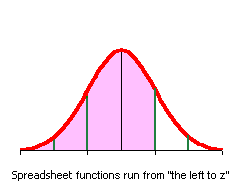
Hitachi makes hard disk drives (HDD) that store information inside a computer. The HDD has a mean time between failure µ of 150 kilohours with a standard deviation σ of 8 kilohours.
| Statistic or Parameter | Symbol | Equations | Excel |
|---|---|---|---|
| Calculate a z value from an x | z | =

|
=STANDARDIZE(x, µ, σ) |
| Calculate an x value from a z | x | = z * σ + µ | = z*σ+µ |
| Find a probability p from a z value (the area to the left of z) | =NORMSDIST(z) | ||
| Find a z value from a probability p (from the area p to the left of z) | =NORMSINV(p) | ||


If you finish early, a non-credit brain teaser: People who buy computers will not understand what is a kilohour. Use the answer to number two to determine the duration in years for the warranty. A kilohour is a thousand hours. Assume the HDD will be running 10 hours a day for 300 days a year.
One promising method of extended HDD life consists of lowering the temperature in the case and improving the drive components (Fig 3). The temperature inside the case depends on the ambient temperature and the heat generated by drive components. According to Yoshihiro Moribe, senior manager, Corporate Planning, Hitachi Global Storage Technologies Japan, Ltd, "If the ambient temperature can be cut by about 10!C, life is doubled. We want people to use our systems at about 25centigrade." One possibility would be to utilize PC water-cooling modules to cool hard disk drives.
If the temperature inside the case is lowered it would mean, for example, reduced evaporation of bearing lubricant from the spindle motor fluid bearings, and of disk lubricant. This would contribute to lower HDD failure rates. Seagate Technology LLC of the US has released data indicating that the mean time between failure (MTBF) at +34centigrade was 150,000 hours, but improved to 230,000 hours at +25centigrade. The annual failure rate is calculated by dividing the number of annual operating hours by the MTBF. Assuming 300 days a year and 10 hours a day, the annual failure rates would be 2% and 1.3%, respectively.
